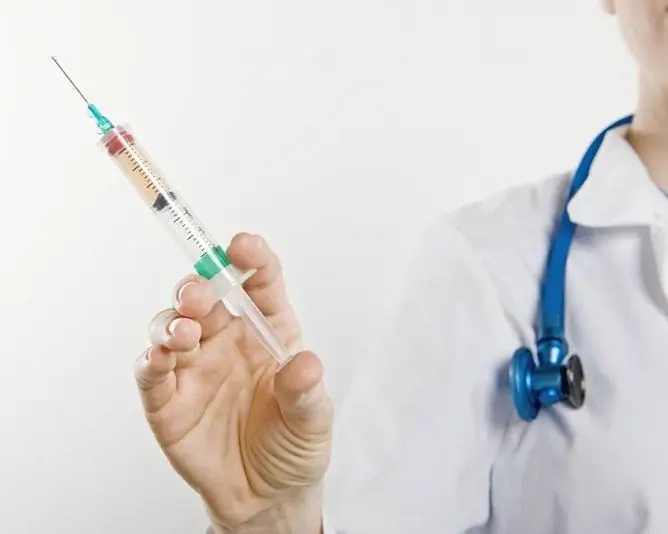- Author Rachel Wainwright [email protected].
- Public 2023-12-15 07:39.
- Last modified 2025-11-02 20:14.
Cefatrin
Cefatrin: instructions for use and reviews
- 1. Release form and composition
- 2. Pharmacological properties
- 3. Indications for use
- 4. Contraindications
- 5. Method of application and dosage
- 6. Side effects
- 7. Overdose
- 8. Special instructions
- 9. Application during pregnancy and lactation
- 10. Use in childhood
- 11. In case of impaired renal function
- 12. For violations of liver function
- 13. Drug interactions
- 14. Analogs
- 15. Terms and conditions of storage
- 16. Terms of dispensing from pharmacies
- 17. Reviews
- 18. Price in pharmacies
Latin name: Cefatrin
ATX code: J01DD04
Active ingredient: ceftriaxone (Ceftriaxone)
Manufacturer: Gepach International (India)
Description and photo update: 2020-07-04
Prices in pharmacies: from 52 rubles.
Buy

Cefatrin is a drug with a broad spectrum of bactericidal action. It belongs to the third generation cephalosporin antibiotics.
Release form and composition
The drug is produced in the form of a powder for the preparation of a solution for intramuscular (intramuscular) and intravenous (intravenous) administration, which is a crystalline powdery mass of white or white with a yellowish tint, slightly hygroscopic (250, 500 or 1000 mg in glass vials with a capacity of 5 or 10 ml, in a cardboard box of 1, 3, 5, 30 or 50 bottles and instructions for use of Cefatrin).
1 bottle contains 250, 500 or 1000 mg of the active ingredient - ceftriaxone (in the form of ceftriaxone sodium trisesquihydrate).
Pharmacological properties
Pharmacodynamics
Cefatrin is a third generation cephalosporin antibiotic. Possesses a wide spectrum of bactericidal action. The drug kills bacteria by suppressing the synthesis of their cell walls. Resistant to the action of most beta-lactamases of gram-positive and gram-negative bacteria.
The following microorganisms are susceptible to ceftriaxone:
- gram negative aerobic bacteria: Enterobacter cloacae, Enterobacter aerogenes, Haemophilus parainfluenzae, Haemophilus influenzae (including penitsillinazoprodutsiruyuschie strains), Morganella morganii, Borrelia burgdorferi, Acinetobacter calcoaceticus, Neisseria gonorrhoeae (including penitsillinazoprodutsiruyuschie strains), Escherichia coli, Moraxella catarrhalis (including penitsillinazoprodutsiruyuschie strains), Proteus vulgaris, Proteus mirabilis, Neisseria meningitidis, Klebsiella spp. (including Klebsiella pneumoniae), Pseudomonas aeruginosa (selected strains), Serratia spp. (including Serratia marcescens);
- gram-positive aerobic bacteria: Streptococcus spp. viridans groups, Streptococcus pyogenes, Streptococcus pneumoniae, Staphylococcus epidermidis, Staphylococcus aureus (including penicillinase-producing strains);
- anaerobic bacteria: Clostridium spp. (excluding Clostridium difficile), Bacteroides fragilis, Peptostreptococcus spp.
Under in vitro conditions, it has been established that Cefatrin is active against a number of other microorganisms [Citrobacter freundii, Citrobacter diversus, Providencia spp. (including Providencia rettgeri), Bacteroides melaninogenicus, Bacteroides bivius, Salmonella spp. (including Salmonella typhi), Shigella spp., Streptococcus agalactiae], but there is no clinical confirmation of this to date.
Many strains of Streptococcus spp. Are resistant to cephalosporins, including ceftriaxone. group D, methicillin-resistant Staphylococcus spp., as well as some strains of Enterococcus spp. (including Enterococcus faecalis).
Pharmacokinetics
The bioavailability of parenteral ceftriaxone is 100%. After intravenous administration, the maximum concentration in plasma is reached already at the end of the infusion, after intramuscular administration - after 2-3 hours. After intravenous administration of 500 and 1000 mg of Cefatrin, the maximum concentration is 38 and 76 μg / ml, respectively; after intravenous administration of 500, 1000 and 2000 mg - 82, 151 and 257 μg / ml, respectively.
In adult patients, 2-24 hours after the introduction of ceftriaxone at a dose of 50 mg / kg, its concentration in the cerebrospinal fluid is several times higher than the MIC (minimum inhibitory concentration) for the causative agents of meningitis. With inflammation of the meninges, the active substance penetrates well into the cerebrospinal fluid. About 83-96% binds to plasma proteins. The volume of distribution is 5.78-13.5 l in adults and 0.3 l / kg in children. The clearance from plasma is 0.58-1.45 l / h, renal clearance is 0.32-0.73 l / h.
After i / m administration, T 1/2 (half-life) is 5.8-8.7 hours. In children with meningitis, after intravenous administration of the drug at a dose of 50-75 mg / kg, T 1/2 is 4.3- 4.6 hours. In patients on hemodialysis [creatinine clearance (CC) 0-5 ml / min] T 1/2 is extended to 14.7 hours, with CC 5-15 ml / min it is 15.7 hours, with CC 16-30 ml / min - 11.4 hours, with CC 31-60 ml / min - about 12.4 hours. From 33 to 67% of the drug is excreted by the kidneys in an unchanged form, another 40-50% is excreted in the bile (intestine, where it is further inactivated). In newborns, up to 70% of ceftriaxone is excreted through the kidneys.
Indications for use
Cefatrin is used for bacterial infections caused by microorganisms sensitive to ceftriaxone:
- acute otitis media;
- lower respiratory tract infections (including lung abscess, pneumonia, and pleural empyema);
- infections of the abdominal organs (inflammatory diseases of the gastrointestinal tract and biliary tract, peritonitis);
- infections of the pelvic organs;
- complicated and uncomplicated urinary tract infections;
- bacterial meningitis;
- infections of soft tissues, skin, joints and bones (including infected burns and wounds);
- bacterial septicemia;
- uncomplicated gonorrhea;
- tick-borne borreliosis (Lyme disease).
In addition, Cefatrin is prescribed for the prevention of postoperative infections, as well as for patients with weakened immunity with various infectious diseases.
Contraindications
Absolute:
- hyperbilirubinemia of newborns;
- breast-feeding;
- joint intravenous administration with solutions containing calcium ions (including in newborns);
- increased individual sensitivity to penicillins, cephalosporins and carbapenems.
Relative (Cefatrin is used with caution):
- hepatic and / or renal failure;
- period of pregnancy;
- colitis, enteritis or ulcerative colitis associated with the use of antibacterial drugs;
- prematurity (in newborns born prematurely).
Cefatrin, instructions for use: method and dosage
Cefatrin solution is administered intravenously or intramuscularly.
For administration, only freshly prepared solutions can be used. Before intramuscular injection, 250 or 500 mg of ceftriaxone is dissolved in 2 ml of 1% lidocaine solution. To dilute 1000 mg of powder, 3.5 ml of solvent (1% lidocaine solution) is used. It is recommended to inject an intramuscular injection of Cefatrin into one buttock at a dose of not more than 1000 mg. If the drug is injected intravenously, then 250 or 500 mg of powder is dissolved in 5 ml of water for injection, and 1000 mg in 10 ml. The prepared solution is injected intravenously slowly (within 2-4 minutes). To prepare a solution for intravenous infusion, 2000 mg of Cefatrin is dissolved in 40 ml of a solvent (5-10% dextrose solution, 0.9% sodium chloride solution or 5% fructose solution). Doses of 50 mg / kg or more are administered intravenously by drip for at least 30 minutes.
For adults, the starting daily dose of Cefatrin depends on the severity and type of infection. Usually it is 1000-2000 mg per day once or in two doses (every 12 hours). The maximum daily dose is not more than 4000 mg.
In order to prevent postoperative complications, the drug is prescribed in a dose of 1000 mg once 30-60 minutes before the start of the surgical operation. If surgery is to be done on the rectum and colon, it is advisable to additionally introduce a drug from the 5-nitroimidazole group.
For the treatment of uncomplicated gonorrhea, 250 mg IM ceftriaxone is prescribed once.
Recommended doses of Cefatrin for children weighing less than 50 kg:
- acute otitis media: 50 mg / kg once / m (the total dose is not more than 1000 mg);
- bacterial meningitis: initial dose - 100 mg / kg (but not more than 4000 mg) once a day, then - 100 mg / kg per day (but not more than 4000 mg) in one or two doses; the course of treatment is from 7 to 14 days;
- infections of soft tissues and skin: 50-75 mg / kg per day in two divided doses (but not more than 2000 mg);
- tick-borne borreliosis: 50 mg / kg per day once (but not more than 2000 mg); the course of treatment is 14 days;
- other infections: 50-75 mg / kg per day in two divided doses (but not more than 2000 mg).
For newborns, the dose of Cefatrin is 20-50 mg / kg per day. For children weighing 50 kg or more, ceftriaxone is prescribed in doses recommended for adults.
Patients with chronic renal failure (CC less than 10 ml / min), as well as combined severe hepatic and renal insufficiency should not be prescribed more than 2000 mg of Cefatrin per day. Patients on hemodialysis after a hemodialysis session do not need an additional dose, but in such patients it is necessary to control the level of ceftriaxone in the blood, since its excretion may slow down.
Treatment should be continued for at least 2 more days after the signs and symptoms of the disease have disappeared. The duration of the course varies from 4 to 14 days. For complicated infections, treatment may be longer. Infections caused by Streptococcus pyogenes are treated for at least 10 days.
Side effects
- digestive system: nausea, taste disturbance, glossitis, stomatitis, vomiting, diarrhea, flatulence, abdominal pain, biliary sludge of the gallbladder, pseudomembranous enterocolitis, pancreatitis;
- nervous system: dizziness, headache;
- hematopoietic system: leukopenia, leukocytosis, anemia (including hemolytic), lymphopenia, neutropenia, thrombocytosis, thrombocytopenia, increased number of basophils and eosinophils;
- cardiovascular system: nosebleeds;
- genitourinary system: hematuria, glucosuria, vaginitis, vaginal candidiasis;
- allergic reactions: skin rash, itching, edema, urticaria, fever, serum sickness, eosinophilia, chills, erythema multiforme, Quincke's edema;
- laboratory test indicators: decrease or increase in prothrombin time, hyperbilirubinemia, glucosuria, hematuria, increased activity of liver enzymes, the presence of sediment in the urine, hypercreatininemia, increased concentration of urea;
- local reactions: with intramuscular injection - a feeling of tightness, compaction or warmth at the injection site, soreness; with intravenous administration - induration, soreness, phlebitis along the vein;
- other reactions: flushing of the skin, increased sweating.
Overdose
In case of an overdose of Cefatrin, symptomatic treatment is prescribed. Peritoneal dialysis and hemodialysis are ineffective in removing ceftriaxone.
special instructions
With prolonged therapy, the indicators of the functional state of the kidneys and liver should be regularly determined, as well as the picture of peripheral blood should be monitored.
On ultrasound of the gallbladder, in rare cases, it is possible to observe blackouts that disappear after the abolition of ceftriaxone. If symptoms appear indicating a possible disease of the gallbladder, as well as if there are signs of biliary sludge, the administration of Cefatrin should be discontinued.
Rare cases of pancreatitis have been reported most often in patients with risk factors for biliary tract stagnation (eg, severe comorbidities, previous drug treatment, or complete parenteral nutrition).
In case of vitamin K deficiency, its additional prescription at a dose of 10 mg per week may be required, especially in the case of prolongation of the prothrombin time before the start of therapy or during treatment.
Due to the danger of the formation of ceftriaxone-calcium precipitates, especially in newborns, Cefatrin should not be mixed with calcium-containing solutions for intravenous administration and should be administered simultaneously with other solutions containing Ca2 +, even through separate infusion systems. The interval between injections of such drugs should be at least 48 hours.
During treatment with ceftriaxone, false positive tests for galactosemia and Coombs' tests are possible. When determining glucose in urine, it is necessary to use the enzymatic method.
Influence on the ability to drive vehicles and complex mechanisms
Cefatrin can cause undesirable side effects from the central nervous system, therefore, during the period of treatment with the drug, patients who drive vehicles or work with potentially dangerous mechanisms are advised to be careful.
Application during pregnancy and lactation
During pregnancy, ceftriaxone is used only in cases where the expected benefit to the mother outweighs the risk of adverse reactions in the fetus.
If there is a need to use Cefatrin during lactation, it is recommended to stop breastfeeding.
Pediatric use
Cefatrin can be prescribed to children from the first days of life, but in newborns (especially premature babies), Cefatrin is used with caution. Ceftriaxone is contraindicated in neonates with hyperbilirubinemia.
With impaired renal function
In patients with impaired renal function, the Cefatrin dosage regimen is adjusted taking into account the CC value. In severe renal impairment, ceftriaxone is used with caution.
For violations of liver function
For patients with hepatic impairment, Cefatrin is prescribed with caution.
Drug interactions
With simultaneous use with bacteriostatic antibiotics, the bactericidal effect of Cefatrin decreases.
In vitro antagonism with chloramphenicol.
When interacting with ethanol, ceftriaxone does not cause disulfiram-like reactions inherent in some cephalosporin antibiotics, since it does not contain the N-methylthiotetrazole group.
Ceftriaxone solution is pharmaceutically incompatible with vancomycin, amsacrine, aminoglycosides, fluconazole and calcium-containing solutions (including Ringer's solution and Hartmann's solution).
Analogs
Cefatrin analogs are Azarexon, Azaran, Axone, Betasporina, Biotraxon, Intrasef, Broadsef-S, IFICEF, Lifaxon, Lendacin, Movigip, Medaxon, Rocefin, Tercef, Torocef, Chizon, Ceftriaxone, Ceftriaxone, Zeftriaxon, Zeftriaxon -Vial, Ceftriabol, Cefson, Stericeph, Oframax, etc.
Terms and conditions of storage
Store in a dark, dry place, out of reach of children, at a temperature not exceeding 25 ° C. Keep out of the reach of children.
The shelf life is 2.5 years.
Terms of dispensing from pharmacies
Dispensed by prescription.
Reviews about Cefatrin
According to reviews, Cefatrin is a strong broad-spectrum antibiotic. It is highly effective and harmful to many bacteria. The drug is usually administered once a day. The antibiotic is inexpensive, but not all pharmacies have it.
The main disadvantages, according to patients, include possible side effects (decreased pressure, stress on the heart, internal edema, etc.). Also, users note that Cefatrin injections are very painful.
Price for Cefatrin in pharmacies
The price of Cefatrin in vials of 1000 mg (5 vials per pack) averages 50-55 rubles.
Cefatrin: prices in online pharmacies
|
Drug name Price Pharmacy |
|
Cefatrin powder for prig solution for in. fl. 1g 52 RUB Buy |
|
Cefatrin 1000 mg powder for preparation of a solution for intravenous and intramuscular administration 1 pc. RUB 55 Buy |

Maria Kulkes Medical journalist About the author
Education: First Moscow State Medical University named after I. M. Sechenov, specialty "General Medicine".
Information about the drug is generalized, provided for informational purposes only and does not replace the official instructions. Self-medication is hazardous to health!






